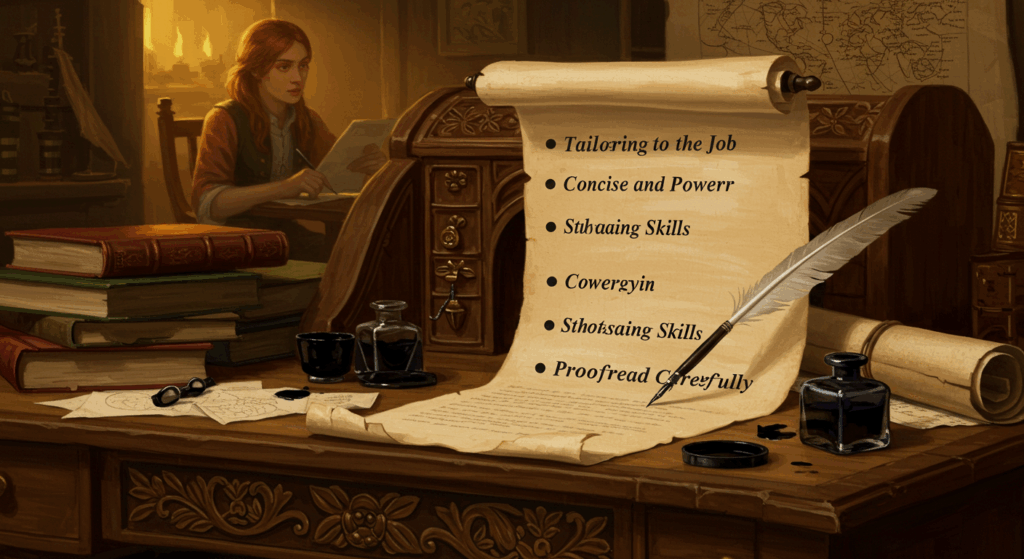If we’re being honest, the phrase “cover letter” sounds like something dusty you’d find in a filing cabinet next to a fax machine. But in real life—and especially in 2025—it’s still one of the easiest ways to stand out in a stack of applications. Not because it’s super formal or extra academic, but because it’s your chance to sound like a person. Think of it as the trailer to your resume’s full movie. The vibe? A quick, human-forward pitch: here’s who I am, here’s why I care, and here’s why you should care too.
I’m gonna walk you through the cover letter meaning in a way that actually helps: the practical definition, the context that makes it work (or not), and the real-world usage so you can send something that lands. We’ll keep it conversational—like a friend hyping you up before an interview—because, ngl, the fake corporate-robot tone makes everyone’s eyes glaze over.
Cover Letter Meaning: the Definition You Actually Need
If you want a one-line definition, here you go:
A cover letter is a short, targeted note that accompanies your resume and tells a specific story about why you fit a specific job, right now.
Notice the repetition of “specific.” That’s the whole trick. Your resume says, “I’ve done these things.” Your cover letter says, “I picked this job on purpose, and here’s the logic.” It’s the bridge between your experience and their needs—like translating your skills into the hiring manager’s language.
A bit more nuance on the definition
- It’s not a biography. No one needs your whole life arc unless you’re writing a Netfix pitch.
- It’s not a filler doc. If you’re just repeating your resume, you’re wasting pixels.
- It’s not about sounding fancy. It’s about being clear, relevant, and a tiny bit memorable (in a good way, not “who sent this chaotic essay” way).
The purpose beneath the definition
A good cover letter does three things fast:
- Connects your background to the role (not generic, this role).
- Signals motivation (you’ve done research, and you’re not mass-applying).
- Reduces risk (you show you understand the job’s problems and can help solve them).
The Context: When a Cover Letter Actually Matters
You can’t talk about cover letters without talking context. (Yes, we’re saying the quiet part out loud.) Are they always read? No. Are they sometimes the reason someone gets a callback? Absolutely.
Situations where the context favors a cover letter
- Career pivots or non-linear paths: If your resume alone doesn’t scream “obvious fit,” your letter connects the dots.
- Creative, strategy, nonprofit, and client-facing roles: Humans hire humans in these spaces; story matters.
- Small to mid-size companies: Less rigid ATS filters, more human review.
- Referrals and networking intros: A tailored letter can make your referrer look good too.
- Internships and early career: Your experience might be thin; your letter carries the “why me” storyline.
Situations where context says “meh”
- High-volume, hyper-technical roles where a portfolio, GitHub, or case study proves more than words.
- Ultra-rigid portals that don’t even let you upload one (still, you can email a short note or paste something in a “message to employer” box).
Bottom line: reading the context helps you decide your level of effort. If there’s a decent chance a human will look, invest in a strong letter. If the portal blocks you, repurpose the same thinking into your application answers or a concise email pitch.
Real-World Usage: How to Use a Cover Letter in 2025
Okay, rubber meets road. What does usage look like now?
Format that doesn’t try too hard
- Length: 250–400 words. That’s it. You can go a bit longer if you’ve got value every sentence, but shorter and sharper usually wins.
- Structure (my fave cheat code): Hook → Bridge → Proof → Close.
- Hook: A relevant opening line (no “To Whom It May Concern” energy).
- Bridge: Why this company/role, in a sentence or two.
- Proof: Two tight mini-stories with results (“I increased X by Y”).
- Close: A friendly, confident sign-off with a mini call-to-action.
- Tone: Polite and professional, but human. Imagine emailing a senior teammate you respect.
- Filename:
FirstName-LastName-CoverLetter-Company-Role.pdf(clean, searchable).
A micro-example (steal the skeleton, not the exact words)
Hi [Hiring Manager Name],
I’m applying for the [Role] at [Company] because your roadmap aroumd [specific initiative] lines up with what I’ve shipped in [relevant area].At [Current/Last Company], I led [project] that [impact/result]. We cut [metric] by [X%] in [timeframe] by [what you did]. I’m especially proud of [short, human detail that shows ownership or learning].
What attracts me to [Company] is [real reason—product, mission, market]. I’d love to bring my experience in [skill set] to help [Company goal], and I’m comfortable moving fast with ambiguity.
Thanks for considering my application—I’d be excited to dig into [problem area] in more detail.
Best,
[Your Name]
That’s the usage pattern: show alignment, show proof, then be easy to talk to.
The “Why You” Clarity: Go Beyond Buzzwords
Let’s be blunt: hiring managers skim. They’re not reading every adjective; they’re hunting for signal. Your job is to reduce friction and make the signal obvious.
Tactics that send real signal
- Quantify: “Grew TikTok followers by 120% in 3 months” > “I managed social.”
- Name the tool + outcome: “Built a Looker dashboard to reduce weekly reporting time by 6 hours.”
- Pattern match to their job post: If they say “cross-functional,” mention the PMs/Designers/Analysts you partnered with and why it worked.
- Mirror their language (lightly): If the posting says “lifecycle marketing,” use that instead of vague “email campaigns.”
Definition vs. Purpose vs. Strategy (So You Don’t Overthink It)
People get stuck because they confuse definition with strategy. The definition is simple: a short note connecting you to the job. The purpose is persuasion. The strategy is how you persuade in this context with this usage. Keep those lanes clear and you’ll write faster.
- Definition: What a cover letter is.
- Purpose: Why it exists (signal fit + lower risk).
- Strategy: The specific choices (tone, examples, keywords) you use for this company.
The Research Step: Non-Negotiable (But Quick)
No, you don’t need to binge every interview and 10-K report. But give yourself 15–20 minutes to collect specifics:
- 2–3 product or campaign facts (“Your Android redesign increased retention,” “You launched in Singapore last quarter”).
- 1 mission or customer insight (what do they care about, who do they serve).
- 1 role-specific challenge you can help with (“Scaling from 10→50 enterprise accounts,” “Cutting churn in student subscribers,” “Moving from manual workflows to automation”).
This tiny research burst gives you inputs to write a letter that doesn’t feel like a copy-paste job ripped from Google Docs templates.
The Hook: Start Like a Human
Your first line sets the mood. Here are some usage-ready hook styles:
- Problem-first: “Subscriber churn spiked for us last summer—here’s how we fixed it, and why I think it maps to your growth goals.”
- Mission-first: “Your mission to make finance feel less scary hits home; I helped 200+ students build budgets without shame.”
- Product-first: “I’ve used your app daily since January; the new onboarding steps made activation feel way smoother.”
- Impact-first: “I love hard, measurable goals. Last quarter I took a lagging channel from 0 to 18% of pipeline.”
Avoid “I’m writing to express my interest in…” unless you immediately follow with a laser-specific reason.
The Proof: Two Mini-Stories > One Grand Claim
Instead of a paragraph of adjectives, drop two concrete vignettes. Keep each to 2–3 sentences:
- Situation → Action → Result with numbers if possible.
- Skill → Collaboration → Impact that mirrors job language.
If you’ve got no metrics (new grads, career switchers, etc.), talk about scope and change:
- “Led a 6-person volunteer team to deliver [X] across 3 campuses.”
- “Designed a 5-step onboarding guide that cut questions in half (verified by our Slack help channel).”
Close with Energy (and an Easy Next Step)
Your last line should be confident, not needy. Try:
- “Happy to share a walkthrough of the dashboard and the template I built.”
- “I’d love to compare notes on your roadmap for creator partnerships in Q4.”
- “If helpful, I can send a 1-pager with experiments I’d run in the first 60 days.”
The P.S. Trick (Yes, It Works)
A short P.S. can increase response rates (it’s like the secret sauce at the end). Examples:
- P.S. I did a 3-slide teardown of your pricing page with two low-lift A/B ideas—can share if that’s useful.
- P.S. I’m local to [City] but fully remote-ready; I overlap [timezone] easily.
Common Mistakes That Quietly Tank Good Candidates
Let’s talk avoidable stuff:
- Generic letters: You can feel when someone didn’t read the posting.
- Repeating the resume: Use the letter to interpret, not duplicate.
- No specifics: “I’m passionate” without proof is background noise.
- Overstatement: Don’t claim you’re a “visionary” because you made a Notion doc.
- Typos in names: Double-check “their” vs. “there,” and the company’s actual capitalization.
- Trying to be quirky for the sake of quirky: This isn’t a stand-up audition. Be warm, not wild.
Different Contexts, Different Angles
Because context changes the playbook, a few quick frameworks:
1. For career changers
- Lead with a portable skill (project management, data, storytelling, stakeholder wrangling).
- Translate industry jargon: “In hospitality, we called it X, but the same system is what you use for Y in SaaS.”
- Offer a quick proof of learning speed (cert, bootcamp, side project with outcome).
2. For students or early career
- Bring club leadership, internships, or class projwects to life with scope + impact.
- Tie your curiosity to their mission (“I’ve been researching dark patterns in UX and your stance on transparency is refreshing”).
- Show initiative: “Drafted a content calendar for a nonprofit; increased event sign-ups by 40%.”
3. For mid-career or management
- Highlight team outcomes (hiring, mentoring, cross-team coordination).
- Emphasize systems built (“Set up rituals, dashboards, and a playbook that outlived my role”).
- Speak the language of trade-offs and resource constraints.
4. For creative roles
- Link to a tight portfolio with case blurbs (goal, role, result).
- Reference audience insight and testing (“iterated against watch-time, not just views”).
- Keep the letter sleek; let the work do heavy lifting.
Usage in Email vs. Upload: Small but Mighty Differences
- Email body: Shorter. Use your Hook → Proof → Close in ~200–300 words, link your resume/portfolio, and make the subject line clean (“Product Designer — Lifecycle + Activation”).
- Upload portal: Full 300–450 words with your best two stories and one sentence about the company’s current priority.
- LinkedIn Easy Apply: If there’s a text box, paste a condensed version. (Yes, someone may read it.)
Keyword Hygiene Without Sounding Like a Robot
Beat the ATS without sounding like ChatGPT had a coffee spill:
- Sprinkle exact phrases from the job post where true (e.g., “SQL,” “lifecycle,” “OKRs,” “qualitative interviews”).
- Keep those keywords near your proof sentences (“I built…” “I drove…” “I partnered…”).
- Avoid an adjective soup. “Detail-oriented, collaborative, proactive, dynamic…”—we get it, you’re a golden retriever with a spreadsheet.
The 4-Block Cover Letter Template You Can Personalize Fast
Use this when you’re tired, it’s midnight, and the posting closes in two hours (been there).
1) Hook (1–2 sentences)
- Specific praise or observation + your angle.
- “Your move into student plans is smart; at CampusOrg, I built acquisition loops that doubled sign-ups.”
2) Bridge (1–2 sentences)
- Why this role/company in this moment.
- “You’re hiring for lifecycle; retention’s been my playground for two years.”
3) Proof (4–6 sentences total)
- Two mini-stories with outcomes.
- “Led onboarding revamp → +18% Day-7 retention.”
- “Built experiment pipeline → 10 tests/quarter, 3 adopted.”
4) Close (1–2 sentences + optional P.S.)
- Friendly CTA + offer to share something useful.
- “Happy to walk through a 60-day plan; thanks for your time.”
This template respects the usage reality: short attention, high impact.
Word Choice and Tone: Sound Like You, Just Cleaner
You can be informal without being sloppy. A few quick usage tips:
- Contractions are fine.
- Jargon is okay if it’s industry-relevant (don’t flex obscure acronyms).
- Humor should be light and relevant (no long bits; this isn’t your open-mic five).
- Confidence beats apology. Drop “sorry for the long message” and “I know I’m not qualified but…”
Formatting Basics So Nothing Breaks on Their Screen
- Single page (if PDF), 11–12pt font, simple typeface.
- Short paragraphs or even bullet points for the Proof section.
- Consistent margins and whitespace—give it breathing room.
- Links (portfolio, GitHub, case study) should be obvious and descriptive, not “click here.”
Advanced Move: The Problem Teardown
If you want to go the extra mile (and the context looks like a human will care), include one sentence that previews your thinking:
- “If I joined, I’d start by segmenting churn reasons (price vs. value vs. UX), running two retention experiments, and pairing with Support for weekly insights.”
It’s a tasty appetizer. You’re not doing free labor—just showing how you think.
Mini-Library of Strong, Short Lines (Copy, Paste, Edit)
- “I like hard problems and short feedback loops.”
- “My happy place is where data and storytelling meet.”
- “I ship, then I measure, then I iterate.”
- “I love building simple systems that teams actually use.”
- “I’m comfortable being wrong on the way to being right.”
Putting “Meaning” in Your Letter (Without Being Cringe)
We keep saying cover letter meaning, but what gives it meaning isn’t a dictionary definition—it’s your intention. Why do you want this job? What makes this company feel like a place where your work would matter? Two sentences of honest motivation can separate you from dozens of “passionate self-starters.”
Try:
- “My dad’s small business struggled with cash flow; tools like yours would’ve changed everything. That’s why this mission lands for me.”
- “I grew up translating tech for my family—making complex things simple is core to how I work.”
Quick Checklist Before You Hit Send
- Did I mention the company/product specifically?
- Did I map my experience to their job description?
- Did I include two mini-stories with outcomes?
- Did I avoid repeating the resume line-for-line?
- Did I proof names, links, and file names?
- Does the tone sound like me on my best professional day?
FAQs You Were Low-Key Thinking
Do people still read cover letters?
Sometimes yes, sometimes no. But when they do, it can be decisive—especially if your path isn’t straightforward.
What if there’s no place to upload one?
Use the email body, the “additional info” box, or send a short note to the recruiter with the same structure.
Should I write one for every role?
Not for every single one. Prioritize roles you really want (or where your resume needs decoding). The context and usage should guide your effort.
What if I don’t have experience?
You have experiences—just not paid ones yet. Projects, clubs, volunteering, self-taught builds, class work with outcomes. Frame them like work: scope, action, result.
Final Thoughts: The Real Meaning Is in the Match
At the end of the day, the definition of a cover letter doesn’t make it powerful—the context and usage do. It’s powerful when it’s targeted, honest, and easy to skim. It’s powerful when it shows how your specific skills and stories align with a company’s specific needs. And it’s powerful when it sounds like a real person you’d actually want on your team.
You don’t have to be Shakespeare. You don’t have to write a long saga. So you just have to connect the dots clearly, back it with a couple of receipts, and invite a conversation.
Quick “Meaning, But Make It Practical” Recap
- Definition: A short, targeted note that bridges your experience to their needs.
- Context: Use letters when a human is likely to read, when you’re pivoting, or when story > bullet points.
- Usage: Hook → Bridge → Proof → Close. Be specific. Be human. Be done in ~300 words.
You got this. Open that job post, pick one real reason you care, grab two receipts from your experience, and write the letter while the coffee’s still warm. Then send it. The future-you who lands the interview? They’ll be very, very proud.









